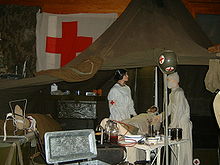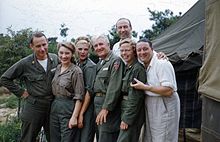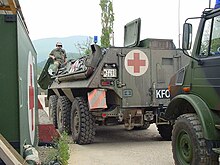The term military medicine has a number of potential connotations. It may mean:
- A medical specialty, specifically a branch of occupational medicine attending to the medical risks and needs (both preventive and interventional) of soldiers, sailors and other service members. This disparate arena has historically involved the prevention and treatment of infectious diseases (especially tropical diseases), and, in the 20th century, the ergonomics and health effects of operating military-specific machines and equipment such as submarines, tanks, helicopters and airplanes. Undersea and aviation medicine can be understood as subspecialties of military medicine, or in any case originated as such. Few countries certify or recognize "military medicine" as a formal speciality or subspeciality in its own right.
- The planning and practice of the surgical management of mass battlefield casualties and the logistical and administrative considerations of establishing and operating combat support hospitals. This involves military medical hierarchies, especially the organization of structured medical command and administrative systems that interact with and support deployed combat units. (See Battlefield medicine.)
- The administration and practice of health care for military service members and their dependents in non-deployed (peacetime) settings. This may (as in the United States) consist of a medical system paralleling all the medical specialties and sub-specialties that exist in the civilian sector. (See also Veterans Health Administration which serves U.S. veterans.)
- Medical research and development specifically bearing upon problems of military medical interest. Historically, this encompasses all of the medical advances emerging from medical research efforts directed at addressing the problems encountered by deployed military forces (e.g., vaccines or drugs for soldiers, medical evacuation systems, drinking water chlorination, etc.) many of which ultimately prove important beyond the purely military considerations that inspired them.











Legal status
editMilitary medical personnel engage in humanitarian work and are "protected persons" under international humanitarian law in accordance with the First and Second Geneva Conventions and their Additional Protocols, which established legally binding rules guaranteeing neutrality and protection for wounded soldiers, field or ship's medical personnel, and specific humanitarian institutions in an armed conflict. International humanitarian law makes no distinction between medical personnel who are members of the armed forces (and who hold military ranks) and those who are civilian volunteers. All medical personnel are considered non-combatants under international humanitarian law because of their humanitarian duties, and they may not be attacked and not be taken as prisoners of war; hospitals and other medical facilities and transports identified as such, whether they are military or civilian, may not be attacked either. The red cross, the red crescent and the red crystal are the protective signs recognised under international humanitarian law, and are used by military medical personnel and facilities for this purpose. Attacking military medical personnel, patients in their care, or medical facilities or transports legitimately marked as such is a war crime. Likewise, misusing these protective signs to mask military operations is the war crime of perfidy. Military medical personnel may be armed, usually with service pistols, for the purpose of self defense or the defense of patients.
Historical significance
editThe significance of military medicine for combat strength goes far beyond treatment of battlefield injuries; in every major war fought until the late 19th century disease claimed more soldier casualties than did enemy action. During the American Civil War (1860–65), for example, about twice as many soldiers died of disease as were killed or mortally wounded in combat.[1] The Franco-Prussian War (1870–71) is considered to have been the first conflict in which combat injury exceeded disease, at least in the German coalition army which lost 3.47% of its average headcount to combat and only 1.82% to disease.[2] In new world countries, such as Australia, New Zealand, the United States and Canada, military physicians and surgeons contributed significantly to the development of civilian health care.[3][4]
Improvements in military medicine have increased the survival rates in successive wars, due to improvements in medical evacuation, battlefield medicine and trauma care.[4][5] Similar improvements have been seen in trauma practices during the Iraq war.[6] Some military trauma care practices are disseminated by citizen soldiers who return to civilian practice.[4][7][8] One such practice is where major trauma patients are transferred to an operating theater as soon as possible, to stop internal bleeding, increasing the survival rate. Within the United States, the survival rate for gunshot wounds has increased, leading to apparent declines in the gun death rate in states that have stable rates of gunshot hospitalizations.[9][10][11][12]
Military medicine by country
editNorth America
editCanada
edit- Royal Canadian Medical Service
- Royal Canadian Dental Corps
- Canadian Forces Health Services Group
- Surgeon General (Canada)
- National Defence Medical Centre
United States
edit- Assistant Secretary of Defense for Health Affairs
- Military Health System
- Military Medicine, academic journal
- TRICARE
- United States Unified Medical Command
- Uniformed Services University of the Health Sciences
- Medical Education and Training Campus
- Henry M. Jackson Foundation for the Advancement of Military Medicine
- Defense Health Agency
- National Center for Medical Intelligence
- Health Professions Scholarship Program
- Joint Task Force National Capital Region/Medical
- Alexander T. Augusta Military Medical Center
- Association of Military Surgeons of the United States
- Tactical Combat Casualty Care
- Armed Forces Institute of Pathology
- Armed Forces Radiobiology Research Institute
- Defense Health Program Budget Activity Group
- Department of Defense Medical Examination Review Board
- National Museum of Health and Medicine
- Medicine in the American Civil War
- National Museum of Civil War Medicine
- Surgeon General of the U.S. Army
- Army Medical Department
- Battalion Aid Station
- Borden Institute
- Combat Support Hospital
- Fort Detrick
- Fort Sam Houston
- Forward Surgical Teams
- United States Army Medical Corps
- United States Army Nurse Corps
- United States Army Veterinary Corps
- Mobile Army Surgical Hospital
- Portable Surgical Hospital
- 68W, the "combat medic"
- Combat Medical Badge
- Expert Field Medical Badge
- Textbook of Military Medicine published by the U.S. Army
- United States Army Medical Department Center and School
- United States Army Medical Department Museum
- U.S. Army Dental Command
- U.S. Army Medical Command
- United States Army Medical Research and Development Command
- United States Army Medical Research Institute of Infectious Diseases
- United States Army Medical Command, Vietnam
- United States Army Medical Command, Europe
- Walter Reed Army Medical Center
- Walter Reed Army Institute of Research
- U.S. Army Public Health Center
- Army Medical School
- United States Army Health Services Command
- Army Medical Museum and Library
- Army Medical Department regimental coat of arms
- Combat lifesaver course
- Surgeon General of the U.S. Navy
- Bureau of Medicine and Surgery
- United States Navy Health Care
- U.S. Navy Medical Corps
- U.S. Navy Dental Corps
- U.S. Navy Nurse Corps
- U.S. Navy Medical Service Corps
- U.S. Navy Hospital Corpsman
- United States Naval Hospital (disambiguation)
- Special amphibious reconnaissance corpsman
- Battalion Aid Station
- Naval Hospital Corps School
- Naval Medical Center San Diego
- Naval Medical Center Portsmouth
- National Naval Medical Center (Walter Reed National Military Medical Center)
- Naval Hospital Yokosuka Japan
- Naval Hospital Guam
- Naval Health Clinic New England
- Naval Health Clinic Cherry Point
- Naval Medical Research Command
- Naval Health Research Center
- Naval Medical Forces Atlantic
- Naval Medical Research Unit South
- Naval Medical Research Unit Dayton
- Naval Submarine Medical Research Laboratory
- Charleston Naval Hospital Historic District
- Old Naval Observatory
- Hospital ship
- USNS Mercy
- USNS Comfort
- Sick bay
- Loblolly boy
- Diving medicine
- United States Navy staff corps
- Surgeon General of the U.S. Air Force
- U.S. Air Force Medical Service (including Dental Corps, Medical Corps, Nursing Corps, and other corps)
- United States Air Force Nurse Corps
- United States Air Force Pararescue
- United States Air Force School of Aerospace Medicine
- Museum of Aerospace Medicine
- Aeromedical evacuation
- Critical Care Air Transport Team
- Expeditionary Medical Support System
- Aviation medicine
Europe
editFrance
editBelgium
editGermany
edit- Bundeswehr Joint Medical Service
- Bundeswehr Medical Academy
- Luftwaffe Institute of Aviation Medicine
- Naval Medical Institute
- Generaloberstabsarzt
- Generalstabsarzt
- Generalarzt
- Oberstarzt
- Oberfeldarzt
- Oberstabsarzt
- Stabsarzt
- Oberarzt (military)
- Assistenzarzt (military)
Italy
edit- Corpo sanitario dell'Esercito Italiano
- Corpo sanitario militare marittimo
- Corpo sanitario aeronautico
- Servizio sanitario dell'Arma dei carabinieri
Russia
editSerbia
editSweden
edit- Surgeon-General of the Swedish Armed Forces
- Medical Corps of the Swedish Armed Forces
- Swedish Armed Forces Centre for Defence Medicine
- Surgeon-in-Chief of the Swedish Army
- Surgeon-in-Chief of the Swedish Navy
- Surgeon-in-Chief of the Swedish Air Force
- Swedish Army Medical Corps
- Swedish Naval Medical Officers' Corps
- Swedish Armed Forces Diving and Naval Medicine Centre
- Swedish Army Veterinary Corps
United Kingdom
edit- Royal Navy Medical Service
- Royal Naval Hospital
- Queen Alexandra's Royal Naval Nursing Service
- Medical Assistant (Royal Navy)
- Institute of Naval Medicine
- Naval surgeon
- Surgeon's mate
- Loblolly boy
- Journal of the Royal Naval Medical Service
- List of hospitals and hospital ships of the Royal Navy
- Army Medical Services
- Royal Army Medical Corps
- Royal Army Dental Corps
- Royal Army Veterinary Corps
- Queen Alexandra's Royal Army Nursing Corps
- Combat Medical Technician
- Medical Support Officer
- Regimental Aid Post
- Territorial Force Nursing Service
- Royal Army Medical College
- Museum of Military Medicine
- RAF Medical Services
- Princess Mary's Royal Air Force Nursing Service
- RAF Centre of Aviation Medicine
- RAF Institute of Aviation Medicine
- Surgeon-General (United Kingdom)
- Defence Medical Services
- Defence Medical Academy
- Ministry of Defence Hospital Units
- Defence CBRN Centre
Asia
editIndia
edit- Director General Armed Forces Medical Services (India)
- Army Medical Corps (India)
- Armed Forces Medical College
- Command Hospital
- Army Hospital Research and Referral
- Military Hospitals
Israel
editSri Lanka
editThailand
editPhramongkutklao College of Medicine
Vietnam
edit- Vietnam Military Medical University (Học Viện Quân Y) in Hanoi
Other regions
editAustralia
edit- Joint Health Command (Australia)
- Australian Army Medical Women's Service
- Australian Army Medical Units, World War I
- Australian Army Nursing Service
- Royal Australian Army Medical Corps
- Royal Australian Army Nursing Corps
- Royal Australian Army Dental Corps
- Australian Army Veterinary Corps
- Australian Army Psychology Corps
- Royal Australian Navy School of Underwater Medicine
- RAAF Institute of Aviation Medicine
- List of Australian hospital ships
South Africa
editInternational
editSee also
edit- Battlefield medicine
- Casualty evacuation (CASEVAC)
- Combat medic
- Combat stress reaction
- Disaster medicine
- Field hospital
- Flight nurse
- Flight medic
- Flight surgeon
- Equipment of a combat medic
- History of military nutrition in the United States
- List of drugs used by militaries
- Medical corps
- Medical evacuation (MEDEVAC)
- Medical Service Corps
- Medical logistics
- Military ambulance
- Military medical ethics
- Military hospital
- Military nurse
- Military psychiatrist
- Military psychiatry
- Military psychology
- Triage
- Stretcher bearer
References
edit- ^ McPherson, James M. (1988). Battlecry of Freedom. Ballantine Books, New York. ISBN 0-345-35942-9., p. 485
- ^ Brockhaus' Konversations-Lexikon; 14th ed., Leipzig, Berlin and Vienna 1894; Vol. 8, p. 939.
- ^ Vivian Charles McAlister. "Origins of the Canadian School of Surgery" Canadian Journal of Surgery (2007) 50 (5) : 357–363. Available at: [1]
- ^ a b c Manring MM, Hawk A, Calhoun JH, Andersen RC (2009). "Treatment of war wounds: a historical review". Clin Orthop Relat Res. 467 (8): 2168–91. doi:10.1007/s11999-009-0738-5. PMC 2706344. PMID 19219516.
- ^ "Chapter 3 – Medical Support 1965–1970". Archived from the original on 2016-06-06.
- ^ Service, Lee Bowman, Scripps Howard News (16 March 2013). "Iraq War 10 year anniversary: Survival rate of wounded soldiers better than previous wars". Archived from the original on 4 September 2018. Retrieved 13 June 2016.
{{cite web}}: CS1 maint: multiple names: authors list (link) - ^ "Military medical techniques saving lives at home – News stories – GOV.UK".
- ^ "The role of the gun in the advancement of medicine". 8 January 2015. Archived from the original on 6 January 2018. Retrieved 13 June 2016.
- ^ Jena, Anupam B.; Sun, Eric C.; Prasad, Vinay (2014). "Does the Declining Lethality of Gunshot Injuries Mask a Rising Epidemic of Gun Violence in the United States?". Journal of General Internal Medicine. 29 (7): 1065–1069. doi:10.1007/s11606-014-2779-z. ISSN 0884-8734. PMC 4061370. PMID 24452421.
- ^ "Lower murder rate linked to medical advance, not less violence".
- ^ Fields, Gary; McWhirter, Cameron (8 December 2012). "In Medical Triumph, Homicides Fall Despite Soaring Gun Violence". Wall Street Journal.
- ^ Harris, Anthony R.; Thomas, Stephen H.; Fisher, Gene A.; Hirsch, David J. (May 2002). "Murder and Medicine: The Lethality of Criminal Assault 1960–1999" (PDF). Homicide Studies. 6 (2): 128–166. doi:10.1177/108876790200600203. S2CID 51845968. Retrieved 1 December 2022.
Further reading
edit- Bowlby, Sir Anthony and Colonel Cuthbert Wallace. "The Development of British Surgery at the Front." The British Medical Journal 1 (1917): 705–721.
- Churchill, Edward D. "Healing by First Intention and with Suppuration: Studies in the History of Wound Healing.” Journal of the History of Medicine and Allied Sciences 19 (1964): 193–214.
- Churchill, Edward D. “The Surgical Management of the wounded at the time of the Fall of Rome.” Annals of Surgery 120 (1944): 268–283.
- Cowdrey, Albert E. Fighting for Life: American Military Medicine in World War II (1994), scholarly history, 400 pp
- Cowdrey, Albert E. United States Army in the Korean War: The Medics War (1987), full-scale scholarly official history; online free
- Fauntleroy, A.M. "The Surgical Lessons of the European War." Annals of Surgery 64 (1916): 136–150.
- Fazal, Tanisha M. (2024). Military Medicine and the Hidden Costs of War. Oxford University Press.
- Grissinger, Jay W. "The Development of Military Medicine." Bulletin of the New York Academy of Medicine 3 (1927): 301–356. online
- Harrison, Mark. Medicine and victory: British military medicine in the Second World War (Oxford UP, 2004).
- Whayne, Col. Tom F. and Colonel Joseph H. McNinch. “Fifty Years of Medical Progress: Medicine as a Social Instrument: Military Medicine.” The New England Journal of Medicine 244 (1951): 591–601.
- Wintermute, Bobby A. Public health and the US military: a history of the Army Medical Department, 1818–1917 (2010).
Primary sources
edit- Kendrick, Douglas B. Memoirs of a Twentieth-Century Army Surgeon (Sunflower University Press, 19920, U.S. Army
External links
editU.S. military medicine
- Military Medicine related links from USAF Air University
- Association of Military Surgeons of the United States (AMSUS)
- Patriot Medicine, a vertical network for the military medical ecosystem
- Military Medicine Through Time. Life and Death in the War Zone | NOVA | PBS
- The Borden Institute Homepage
- Military Medicine Documents at USU Archive
- U.S. Army Preventive Medicine news archive from the 7th Infantry Division (Light) Panorama weekly newspaper 1988.
- Virtual Naval Hospital – a digital library of military medicine and humanitarian medicine
- http://www.ipernity.com/doc/57114/5652001/in/keyword/487917/self (military medical exams)
Australian military medicine
International Magazine for Military Medicine
- MCIF MEDICAL CORPS INTERNATIONAL FORUM International Magazine for Military Medicine
NATO Centre of Excellence for Military Medicine